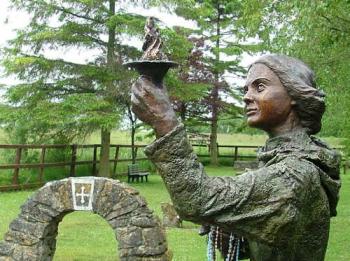 On February 1st in Ireland we celebrate the Feast of St. Brigid of Kildare. With St. Patrick and St. Colmcille she is one of the three patron saints of Ireland.
On February 1st in Ireland we celebrate the Feast of St. Brigid of Kildare. With St. Patrick and St. Colmcille she is one of the three patron saints of Ireland.
Who is this Brigid and what do we know about her? While it is believed that she was born in the middle of the fifth century, the Life of Brigid (Vita Brigitae) was not written until the later part of the 7th century. It is full of stories and legends that illustrate her faith, hospitality, concern for the poor and oppressed, healing powers and great sensitivity to God's creation.
Most scholars believe that Brigid was born in Faughart, County Louth around the year 453 A.D , though there is a also a tradition that she was in fact born near the town of Kildare. In the latter version, her mother, Broicsech a Christian, was a bondmaid in the household of a local chieftain called Dubthach.
This was a time when the traditional religion of the druids was waning and giving away to the new faith, Christianity. The change over happened in a relatively short period of time and without violence. Around the year 480 A.D Bridget established her abbey in Kildare, in a place which is now occupied by the Church of Ireland Cathedral of St. Brigid. Of course, nothing remains of the original building, as it was most probably constructed from timber, mud and wattles.
Some scholars claim that her monastic foundation may have grown out of a sanctuary for Druidic priestesses who had converted to Christianity. The fact that she presided as Abbess over a monastery which included both men and women, may have a message for the contemporary Catholic Church, where traditional forms of ministry are crumbling. Today women are rightfully seeking a much more inclusive role in every aspect of the Church's life, including leadership roles.
There was not, of course, a clear break between the druidic past and the emerging Christian faith. No Irish saint embodies this transition better than Brigid. Legends about here are intertwined with stories about female Celtic deities. Her feast day, celebrated at the beginning of the year, coincides with the ancient Druidic feast of Imbolc and retains many features of that festival, especially in relation to holy wells and the ceremonial use of fire. Her Feast points to new life emerging in spring.
Brigid's fame as a peacemaker has much to teach our modern world. During her life there were many quarrels and wars between rival clans and rival families within clans. Brigid often became involved in reconciling rival factions. There is a legend that she gave away her father's sword to a poor family so that they could buy food. Today, where almost one billion are constantly hungry, the nations of the world together waste £1.3 million per minute on weapons of war and destruction.
Brigid was a friend of the poor. One of the legends has Brigid resting on the road during a long journey. A wealthy lady heard that the famous Brigid was in the locality and brought her a basket full of delicious apples. No sooner had the gift been presented to the saint, than a group of poor people passed by and asked for food. Without hesitation Brigid gave them the apples. The donor was annoyed and disgusted and said to Brigid, "I brought those apples for you , not for them." Brigid replied, "what is mine is also theirs." As we watch the death, pain and hunger which followed the recent earthquake in Haiti on our TV screens, we are reminded that there are still many people, in various parts of the world, who are desperately in need of our apples.
Today, when many people are concerned about how humans are destroying creation, Brigid's closeness to the land should help us regain a new sensitivity to God's creation. She is often presented as milking cows, churning milk or making butter, shepherding her flocks of sheep and even brewing ale.
Water resources are under stress all across the world and, in the year 2010, almost one billion people lack access to clean, potable water. St. Brigid's well has attracted pilgrims down through the ages. In pre-Christian Celtic Europe wells were associated with a strong presence of the divine. They were seen as the entrance to the womb of mother earth and therefore as the source of life. Holy wells also became symbols of the source of life within each person. We need to recover this reverence and respect for water in our times.
A Naoimh Bhrid, Muire na nGeal, gui orainn - St. Brigid, Mary of the Gael, pray for us.
Fr Sean McDonagh SSC is a researcher on Justice Peace Integrity Creation (JPIC) priorities.